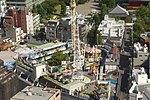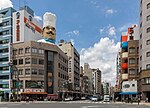Asakusa Station (Tsukuba Express)
AsakusaInternal link templates linking to redirectsRailway stations in Japan opened in 2005Railway stations in TokyoStations of Tsukuba Express

Asakusa Station (浅草駅, Asakusa-eki) is an underground railway station on the Tsukuba Express line in the Asakusa district of Taito, Tokyo, Japan, operated by the private railway operator Metropolitan Intercity Railway Company. It is numbered "TX03". While this station is situated relatively close to the station complex of the same name serving the Ginza Line, the Asakusa Line and Tobu Railway, there are no transfer passageways between these two stations. Passengers transferring between these stations must transfer at street level, as the latter station is located 600 meters to the east.
Excerpt from the Wikipedia article Asakusa Station (Tsukuba Express) (License: CC BY-SA 3.0, Authors, Images).Asakusa Station (Tsukuba Express)
Kokusai dōri, Taito
Geographical coordinates (GPS) Address Nearby Places Show on map
Geographical coordinates (GPS)
| Latitude | Longitude |
|---|---|
| N 35.7132509 ° | E 139.7923082 ° |
Address
福楽
Kokusai dōri
111-0035 Taito
Japan
Open on Google Maps










